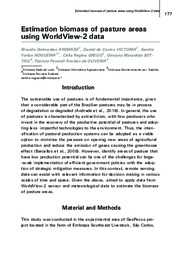Estimation biomass of pasture areas using WorldView-2 data.
Estimation biomass of pasture areas using WorldView-2 data.
Author(s): ANDRADE, R. G.; VICTORIA, D. de C.; NOGUEIRA, S. F.; GREGO, C. R.; BETTIOL, G. M.; OLIVEIRA, P. P. A.
Publication year: 2016
Types of publication: Paper in annals and proceedings
Unit: Embrapa Dairy Cattle
Keywords: Agropecuária, Gases de efeito estufa
Observation
Some of Embrapa's publications are published as ePub files. To read them, use or download one of the following free software options to your computer or mobile device. Android: Google Play Books; IOS: iBooks; Windows and Linux: Calibre.
Access other publications
Access the Agricultural Research Database (BDPA) to consult Embrapa's full library collection and records.
Visit Embrapa Bookstore to purchase books and other publications sold by Embrapa.

